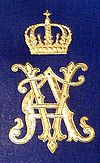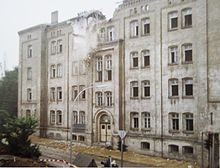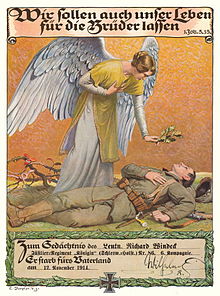Fusilier Regiment "Queen" (Schleswig-Holstein) No. 86
|
Fusilier Regiment "Queen" (Schleswig-Holstein) No. 86 |
|
|---|---|

|
|
| active | 1866 to 1919 |
| Country |
|
| Armed forces | Prussian Army |
| Branch of service | infantry |
| Insinuation |
IV. Army Corps from 1867 IX. Army Corps |
| Former locations | Halle (Saale) , Flensburg , Alsen |
| Trunk number | 86 |
| Anniversaries | September 9, 1890 |
| Butcher |
Franco-Prussian War First World War |
| Commander | |
| Commanders | see commanders |
The Fusilier Regiment "Queen" (Schleswig-Holstein) No. 86 was an infantry joined the Prussian army .
history

After the war against Austria on September 27, 1866, the association was formed from companies of Infantry Regiment No. 16, 17, 56 and 57 by the 14th Division . It was initially called Infantry Regiment No. 86 and received by AKO on September 27, 1867, which u. a. Allocation and recruitment regulated, the provincial designation "Schleswig-Holstein". Kaiser Wilhelm II had appointed his wife Auguste Viktoria to head the regiment on September 9, 1890 . From this point on, the association therefore added the addition "Queen".
The first place of deployment was Halle (Saale) for the regimental staff and the 1st and 2nd battalions. The fusilier battalion was in Zeitz . After winning the war against France , the regiment received a new garrison, which it moved in July 1871. The regimental staff as well as the I. and II. Battalion were in Flensburg , the III. Battalion stationed in Sønderborg . The part of the regiment stationed in Flensburg moved into the newly built Duburg barracks in 1877 .
1909 was awarded the regiment an MG - company engaged in the Junker ravine barracks was located in Flensburg.
Franco-German War 1870/71
The mobilization ordered on the night of July 15-16, 1870, was completed by July 24th after the reservists had arrived. The next day the regiment moved to Mannheim and on August 7, 1870, in silence, crossed the border into France . At the end of the month the association took part in the fighting at Beaumont and the subsequent Battle of Sedan . This was followed from September 19, 1870 to January 28, 1871 by the enclosure and siege of Paris . Parts of the regiment fought on January 19, 1871 near St. Quentin .
The association remained as an occupying force in and around Meulan until May 30, 1871 .
Boxer Rebellion
Two officers, ten NCOs and 56 men from the regiment volunteered to help put down the Boxer Rebellion . It was mainly used in the 3rd East Asian Infantry Regiment in China .
German South West Africa
On the occasion of the Herero and Nama uprising , soldiers of the regiment volunteered again. In 1904/06 an officer, two NCOs and 21 men were deployed in German South West Africa .
First World War
At the beginning of World War I , the regiment mobilized on August 2, 1914 and was deployed on the Western Front throughout the war . At first it took part in the invasion of neutral Belgium in association with the 35th Infantry Brigade , fought near Liège , Gete and Mons . During the fighting on the Aisne from October 8, 1914, briefly released from the brigade , the regiment was reassigned to this large formation on December 22, 1914 . On March 8, 1915, the association came to the 36th Infantry Brigade and received a 13th and 14th company on March 22, 1915. From mid-October to early November 1915, the regiment took part in the autumn battle in Champagne and then fought there in position battles . After the Battle of the Somme , a 2nd and 3rd MG company were set up in October 1916 . During the defensive battles at Grougis , the 1st and 2nd Battalions were taken prisoner. A short time later the regiment was replenished and an MW company was added. In the ongoing fighting in front of and in the Hermann position , the 1st Battalion at Tupigny was taken prisoner. Due to the inadequate replacement position , the regiment could no longer be replenished and the remnants were combined with the 2nd Battalion.
Whereabouts
After the Compiègne armistice , the remnants of the regiment marched back home. The association was from December 25, 1918 in Flensburg, the III. Battalion in Sønderborg demobilized and then disbanded.
The tradition in the Reichswehr was adopted by the 12th Company of the 6th Infantry Regiment in Flensburg by decree of the Chief of the Army Command, General of the Infantry Hans von Seeckt , on August 24, 1921 .
Commanders
| Rank | Surname | date |
|---|---|---|
| Lieutenant Colonel / Colonel | Alexander von Heinemann | October 30, 1866 to March 21, 1868 |
| Colonel | Alfred von Krohn | March 22, 1868 to April 26, 1869 |
| Colonel | Adolf von Horn | April 27, 1869 to October 11, 1872 |
| Lieutenant Colonel / Colonel | Oskar love | October 12, 1872 to November 11, 1878 |
| Colonel | Wilhelm Dresow | November 12, 1878 to December 5, 1883 |
| Colonel | Oskar Meyer | December 6, 1883 to March 10, 1886 |
| Lieutenant Colonel / Colonel | Ludwig von Kusserow | March 11, 1886 to March 21, 1889 |
| Lieutenant Colonel / Colonel | Adolf Otto Berger | March 22, 1889 to November 16, 1891 |
| Colonel | Karl von Vietinghoff called Scheel | March 19, 1891 to March 18, 1896 |
| Colonel | Eduard von Lütken | March 19, 1896 to April 17, 1899 |
| Colonel | Kurt from Medem | April 18, 1899 to November 26, 1902 |
| Lieutenant colonel | Siegfried von Ende | November 27, 1902 to January 26, 1903 (in charge of the tour) |
| Colonel | Siegfried von Ende | January 27, 1903 to April 13, 1907 |
| Colonel | Erich von Luckwald | April 14, 1907 to March 19, 1911 |
| Colonel | Friedrich von Wartenberg | March 20, 1911 to December 4, 1912 |
| Colonel | Veit von Obernitz | December 5, 1912 to October 3, 1914 |
| Colonel | Alexis von Stein-Liebenstein zu Barchfeld | October 4, 1914 to January 5, 1915 |
| Lieutenant colonel | Friedrich Ash | January 6-22, 1915 |
| Lieutenant colonel | Joachim von Schäffer | January 23 to June 5, 1915 |
| Lieutenant colonel | Leo von Paczensky and Tenczin | June 6 to July 18, 1915 |
| major | Walter von Kielmannsegg | July 19, 1915 to October 1, 1916 |
| Lieutenant colonel | Hans von Drygalski | October 2, 1916 to 1919 |
uniform
The uniform badges were initially red epaulettes with yellow numbers “86” and a light blue protrusion on the sleeve flaps . With the transition to the IX. Army Corps in 1867, the epaulettes were white and the sleeve flaps received a yellow advance. With the appointment of Auguste Viktoria as head of the regiment, the "86" was dropped and was replaced by the queen's monogram .
literature
- Richard Windeck: History of the first 25 years of the Royal Prussian Fusilier = Queen Regiment (Schleswig = Holstein) No. 86. Mittler and Son, Berlin 1894.
- Queen Fusiliers. History of the Queen's Fusilier Regiment (Schleswig-Holsteinschen) No. 86. Carl Jacobsen Verlag, Leipzig 1906.
- Dr. Wilhelm Juergensen: The Fusilier Regiment "Queen" No. 86 in the World War . Memorial sheets of German regiments. Volume 101, Verlag Gerhard Stalling, Oldenburg iO 1925.
- Jürgen Kraus : Handbook of the associations and troops of the German army 1914-1918. Part VI: Infantry. Volume 1: Infantry Regiments. Verlag Militaria, Vienna 2007, ISBN 978-3-902526-14-4 , p. 155.
Web links
Individual evidence
- ^ Günter Wegmann (Ed.), Günter Wegner: Formation history and staffing of the German armed forces 1815-1990. Part 1: Occupation of the German armies 1815–1939. Volume 2: The staffing of the active infantry regiments as well as the hunter and machine gun battalions, military district commands and training managers from the foundation or list until 1939. Biblio Verlag. Osnabrück 1992. ISBN 3-7648-1782-8 . P. 221f.



